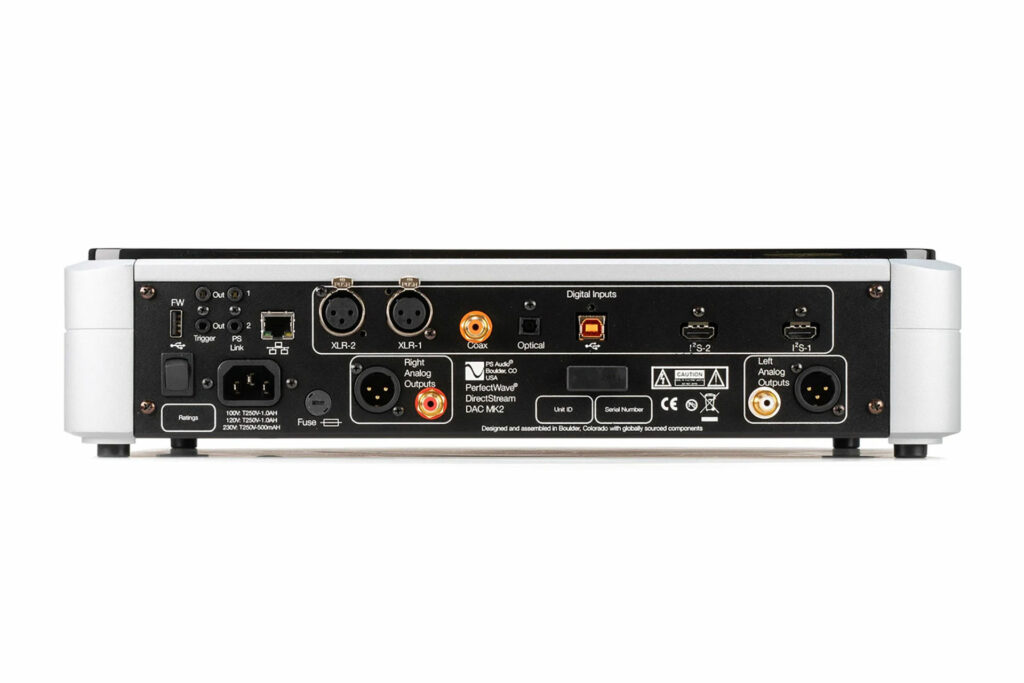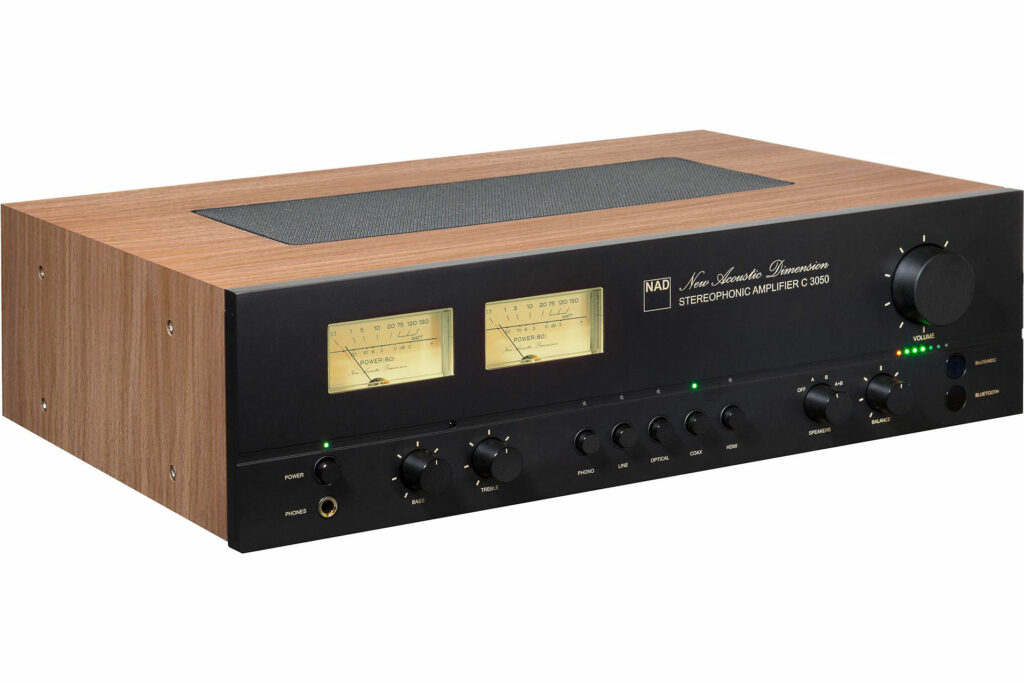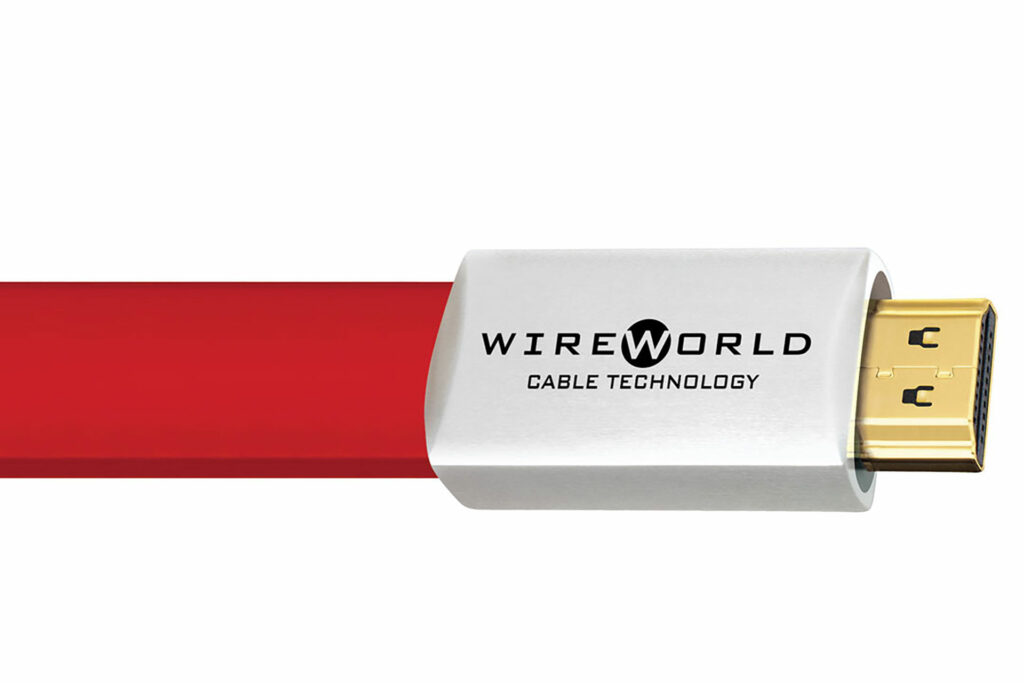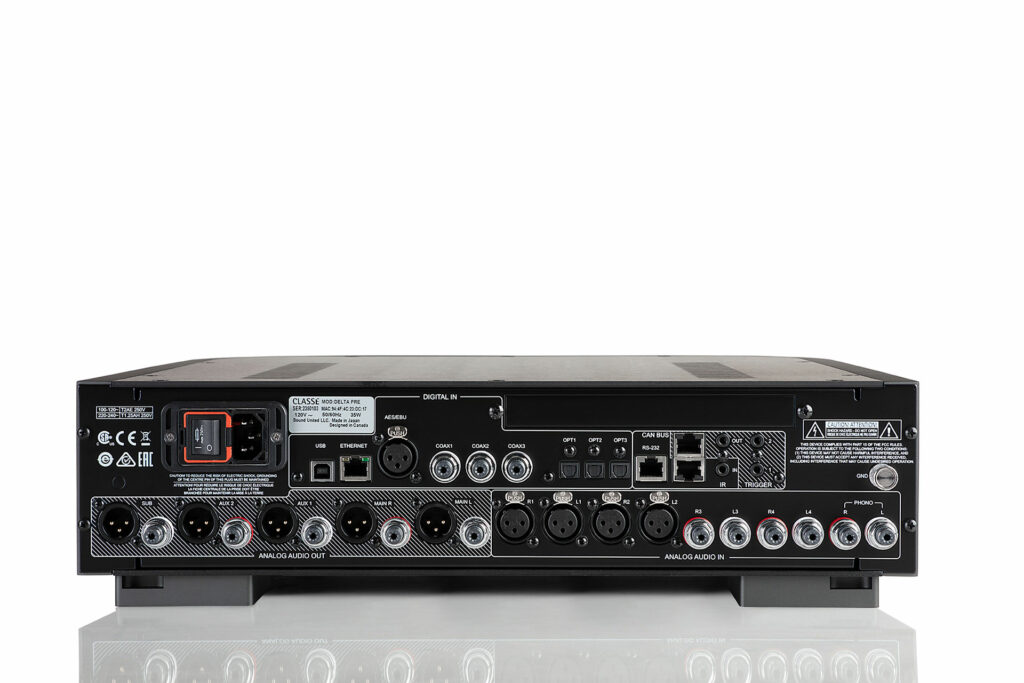The worlds of high-performance audio and home theater should get along better than they do most of the time. Most good AV stores that sell audiophile components also sell home theater systems. In these magical systems, home theater things connect almost exclusively by HDMI. These simple and affordable cables provide a solid connection for high-resolution content, be it HD audio or up to 8K video. HDMI also provides content creators pretty robust copy-protection scheme, which was much of the conflict that left no winners in the audiophile format wars between Sony’s SACD and DVD-Audio. There are a lot of benefits to HDMI.

Content is King When It Comes to HDMI, Be It For Audio or Video
Yes, you can connect your TV to your soundbar or AV receiver via HDMI, but how many audiophiles take the time to connect their video sources to their main music systems? Not nearly enough is the answer. There are many age-old cliches in the audiophile hobby, and one of them is that anything video-related is bad. The TV is an acoustical problem. The TV gets in the way of seriously listening to music. These are the arguments that people make, but they aren’t strong arguments. The reality is that, more than movies and most of today’s popular music, television is creating the most incredible content. Why wouldn’t you want that sound coming from your kick-ass audio system?
Creatively, what is the difference between, say, John Coltrane at his mid-1960s best and Kate Winslet in The Regime on Max in 4K? Both performances are brilliant. Both are quite enjoyable and both are worthy of your time. How could one not be worthy of playback in your best audio system?

Getting Beyond Wife Acceptance Factor in Your Audio System
One of the worst audiophile myths is that women don’t like listening to music. That’s just fundamental bullshit. Not only do women love to listen to music but, in so many cases, they can actually hear better than men. That’s simple biology, as men lose their hearing more rapidly over time than women. But you don’t have to spend much time at a regional audiophile show to see that the male-female demographic split lands right in the sword-fight territory each and every time. Generously, there might be one woman for every 20 men at an industry event like an audiophile show. Perhaps there is some growth in the hobby if the collective “us” embraces roughly 50 percent of the population with our passion for luxury music playback.
How do we woo more women into the hobby? How about making watching television (or movies, for that matter) more a part of the fun? Was The Sopranos worth the extra effort to hear though your Wilsons or MartinLogans? You’re damn right it was, and the same goes today with the excellence that is on TV – especially streaming from any number of paid providers.
The worst objection that a stereo salesperson will ever hear is, “I have to clear this with my wife.” It gives me chills to write the words. But what if your wife actually liked listening to music with you? What if she researched and picked out shows for you to stream into your audiophile system via, say, an Apple TV, a Roku, or even a Kaleidescape? Do you turn into a pumpkin or lose your Audiophile Club Platinum Card if you aren’t exclusively spinning vinyl or streaming 24/192 files? Nope. In fact, you open a lot of doors for yourself in the hobby. If men can explain why the hobby delivers so much joy, perhaps there would be a lot less family financial conflict over that new component upgrade? After 9/11, the number one golf course in the world, Pine Valley, opened the doors to their massively exclusive club for anyone willing to pop for a $10,000 donation to charity. The phones rang off the hook with wives signing up for their husband’s once-in-a-lifetime experience. I know a Gen X audiophile in the Southeast whose wife loves audio. She also bought him a pair of pricey yet sexy Rockport speakers. Audiophile matters can be a shared passion if some of the antiquated stereotypes would be debunked and abandoned.

Can Audiophiles Get Better Sound from an HDMI Connection?
We’ve got an article waiting to publish that explains the advantages and disadvantages of all of the different digital cables that might connect a music source. Did you know HDMI is one of them? Philips I2S is a very capable HD audio (only) connection that can perform, in the right configuration, as well as the best other options, including my personal favorite, AES-EBU. PS Audio is using I2S in their DACs and other digital components, and they are not the only ones embracing what HDMI can do for audio.
It can be tricky to do an experiment to hear and compare different audio cable connections. One key concept is to match volumes. There can be other factors that make this process tricky, but I’d love to do some in-studio listening to what I2S can do in the world of high-performance audio. I have a sneaky feeling that it might be a strong performer.
Why Do Audiophile Companies Resist Designing Their Gear With HDMI?
Many bigger companies in the audiophile market have embraced full HDMI for audio in their component. PS Audio is using HDMI as a digital audio cable, but companies like Classe Audio (Masimo), NAD (Lenbrook) and others are putting HDMI into their better audiophile-grade gear. The NAD C 3050 won our first FutureAudiophile.com Product of the Year Award for their $1,399 integrated amp that, along with a Class-D amp, room correction, and an internal endpoint, also has HDMI inputs.
The easy answer as to why so many audiophile companies resist HDMI is that they can’t accept change, but that’s not really the case here. Issue number one is that HDMI is pretty damn expensive to license. Tens of thousands of dollars for a seemingly tangential input option can be a total deal-breaker for a smaller, less well-heeled audiophile company. The next issue, that the engineering needed to bring HDMI into an audiophile product, is not inconsequential. How do you deal with video – if at all? Does bringing in more features impact the sound elsewhere? That’s always a concern. Support is another concern, in that HDMI can have its moments, as audiophile connections don’t always connect as you might want them to. Handshake issues with HDMI are well-studied, and problems like that can complicate what would otherwise be a much simpler audiophile component.
What is the Realistic Potential of HDMI in the Audiophile World?
The idea of turning every fancy stereo preamp into a full-featured AV preamp with all of those complexities is not the point here. Bringing in HDMI as an HD audio option is a very reasonable option that would likely be nicely received by the community and its consumers.
Being able to accept a signal loaded with HD audio and video via a gaming console opens up the real potential of the format for the future growth of the audiophile hobby. Video games are a bigger business than music and movies combined, and soon will be double both music and movies combined, yet the audiophile industry doesn’t cater to this audience. Anybody looking for a new generation of people who a) love music, b) appreciate high-performance tech, and c) knows why it costs a lot of money to get the Nth degree of performance from your rig – you’ve just summed up the Gamer. How does the gamer connect to their rig? Physical cables (they are faster and better in an environment where every increment of performance matters), which often are HDMI. This is not an audience that should be overlooked by audiophile companies that know that they are going to appeal to a new generation of client.

Final Thoughts on HDMI for Audiophiles…
We like to take on the cliché and voodoo in the audiophile hobby and shatter the myths. HDMI being somehow bad for the audiophile hobby is such a myth. While there are costs and complexities to working with HDMI, the upsides well outweigh the downsides. The simplicity of connection is a major draw. HD performance for audio (and beyond) is a very tempting next point. The appeal to a new audience that can start out and grow their interest in the hobby as they become more established financially.
There is so much upside to HDMI, even for audiophiles. Yes, it represents change, but that change is already here and isn’t likely to go away. The audiophile business, especially on the digital side of audio, has had to Keep Up with the Joneses and HDMI is possibly the next chapter. When you are owned by a multi-billion-dollar, publicly-traded company, and your sister brands are Denon and Marantz, how hard is it to license HDMI for something like Classe’ Delta PRE DAC-Preamp? Not that hard. For a company like, say, Audio Research, implementing HDMI will take a lot more time, engineering and overall change. Would I suggest to Val (the new owner of Audio Research) that this is something that future ARC preamps need? You’re damn right, I would.
How do you deal with HDMI in your audiophile system (if at all)? Do you see it as a feature or connection option that you might be into? Would you try I2S on an audio-only basis via HDMI? Let us know where you stand on HDMI in the moderated comments below.




HDMI is important if you want to play back SACDs or DSD from your transport through your DAC. I don’t know any modern way to do it since Firewire is a thing of the past? It’s a shame most DACs don’t have it.
I guess I’m an old timer, since my interest in getting good sound from Television goes back to the days when TVs had no audio outputs and you were just stuck with the fidelity of the sound your TV speaker provided. So, I added an audio output connector to my $50 Philco TV to connect it to my Heathkit stereo system. Since TV audio was FM, the audio quality of the sound I was getting was amazing compared to what was available on your basic TV. Listening to Johnny Carson with Doc Severinsen’s band sounded so good I knew one day I would have to go to a live taping of the show just to experience the band live.
I recently purchased a TV from a major TV manufacture that had no analog audio outputs, not even a headphone jack. To extract decent sound from the TV I had to buy a Digital Audio Optical to RCA converter and Toslink fiber cable. This was not expensive and more readily available than I expected, but the need for me to do this seem totally ludicrous. Did the manufacture really save anything by providing an optical output rather than a headphone jack? Do they really think most people buying a 35” TV are more likely to want an optical audio over an analogue output? This is just another example of poor short term interface decisions made by the video industry that ignore the need to integrate with hi-fi audio equipment. So, I think there is a lack of trust by audiophiles that video manufactures will make decisions that consider audio quality.
I mention this because in most cases you can figure out a way of getting a analogue audio out of your TV, Cable box, or modestly price AV receiver if you do just a little investigation. If you don’t have an analogue output, there are many converter box type devices available for converting digital outputs to audio analogue for less than $50.00, cables included. Among these are HDMI Audio Extractors. The quality of the devices does vary, but all will relieve you from being hostage to the horrible sound of TV speakers or most sound bars and you will not have to wait for the equipment manufactures to arrive with a better interface to high end audio. Most TVs allow you to adjust the timing between the video and audio so you will be able to sync the sound and picture properly.
I think one of the great things about analog audio components is that the cable interface has remained the same. You pretty much have RCA or XLR, which makes it easy to interface with both vintage and current equipment. Contrast this with video components. I realize video resolution has driven video interfaces, but the migration of composite, S-video, component, and various versions of HDMI interfaces has made huge amounts of equipment obsolete due to interface incompatibilities. Add to this the countless versions of surround formats and you can see why audiophiles might suspect the video manufactures will continue to produce numerous permutations of audio interfaces while ignoring compatibility considerations.
It is not completely clear to me if Jerry’s personal favorite AES-EBU interface is referring to or includes SPIDF, but if so, might this or a Coaxial output that uses an RCA connector be a better option than HDMI? It would seem doing so would eliminate the high licensing cost, dealing with video, hand shaking issues associated with HDMI. But, perhaps the Futureaudiophile future article covering the advantages and disadvantages of the different digital cables that might connect a music source will cover all this and more..
The problem with these interfaces is they won’t pass high resolution audio like Bluray or DSD.
Doug, unless the TV’s standalone most people connnect their TV to an AVR via HDMI-ARC or optical & have separate systems for TV & music. Who wants to stare at a giant (blank) screen while listening to music, not me!
I enjoy listening to SACD DVDA and Bluray in stereo through a high quality DAC. HDMI is the only way to make it work natively. And it requires a monitor to navigate the menus.
My system definitely is a hybrid with 77” Oled with a AUDIOQUEST 2.2 HDMI to a Denon 4K AVR that is bypassed through a tube preamp (Prima Luna) to either a pair of Quicksilver mono tube amps or a solid state amp (Parasound A21+) out to Maggie 1.7i’s (heavily modded) (I use a Luxaman switcher for the different amps depending on the vibe I want). So, yes, there is a big ass TV in the middle of my system (the top row of the equipment cabinet under the TV hosts a Rega TT plus its SUT with LPS; A DefTech center channel and the Prima Luna). Two Martin Logan subs, a for each side, and 4 DefTech surround speakers surround perched high around the this listening space which is a family room, NOT A CAVE). Ok, already, how does it all sound? I never want to leave home. Ever. I just added shelves to a spare bedroom for additional LPs, about a 1,000 Blu-rays/4k movies and another 1500 CDs (yes, I have digital: CD player, Bluesound Node 2 fed into a Schitt Gungnir MB dac). I list all this stuff not promote the intimadating aspect of audio/visual connectivity, but to support any of you out there who feel you must adhere to any vision other than your own. I love my music, AND my movies,, AND those gorgeous TV shows on the streaming services. It all sounds and looks great. My wife? Loves it. Hats off to the writer of this review, ‘bout time someone stood up for us hybriders.
NICE!!!!
Phil, have you tried Blu-Ray audio discs? They are usually better sounding than SACDs. And they are becoming more prevalent. Ziggy Stardust and Selling England by The Pound sound amazing on Blu-Ray.